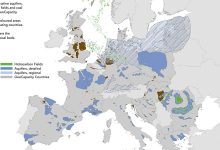US to Ensure Additional LNG Volumes for the EU
15 bcm of Gas in 2022
Ukraine’s invasion by the armed forces of the Russian Federation have determined the European Union to undertake to reduce by two thirds the Russian gas consumption this year, by increasing imports from other countries and stimulating renewable energy. In this context, the United States have stated that they would strive to ensure, including in collaboration with international partners, additional liquefied natural gas (LNG) volumes for the EU market of at least 15 billion cubic meters in 2022.
During the visit of the President of the United States of America, Joe Biden, to Brussels, a joint statement with the European Commission was adopted, according to which the two parties will establish an operational group to “strengthen the energy security for Ukraine and the EU for the next winter and the following”.
The European Union has set out to uncouple from Russian gas, given that last year imports from the Russian Federation reached 155 billion cubic meters. At the same time, the EU imported last year 22 billion cubic meters from the US. The European Commission has announced that it would collaborate with all the EU states to ensure a “stable demand for additional LNG from the US by 2030” of 500 billion cubic meters per year. European Commission President Ursula von der Leyen mentioned that the added volume would replace one third of Russian gas imports. Also, both the EU official and the US President have mentioned that the EU gas infrastructure would be adjusted in the following period to also take over green hydrogen.
Joe Biden: Crisis is an opportunity
“This crisis also presents and opportunity. A catalyst that will drive the investments we need to double-down on our clean energy goals and accelerate progress toward our net-zero emissions future,” the US President highlighted.
The second part of the agreement concluded between the EC and the US is to impose measures to reduce Europe’s overall gas demand, Biden also mentioned, pointing out green solutions such as the use of hydrogen, increased energy efficiency.
In early March 2022, the US announced that it would ban Russian fuel imports.
The EU relies on energy savings and renewable sources
In the joint statement, the US and the European Commission have committed to reduce the greenhouse gas intensity of all new LNG infrastructure and associated pipelines, including using clean energy to power onsite operations, the reduction of methane leakage, and the construction of clean and renewable hydrogen ready infrastructure.
The EU relies on clean energy and energy efficiency to reduce a large part of its gas demand. It promised to reduce bureaucracy in the energy sector, including for the LNG infrastructure, and stimulate the implementation of renewable sources.
The decision-makers in Brussels estimate that energy savings can reach 15.5 billion cubic meters of gas this year, while the new wind and solar power plants can replace other 20 billion cubic meters of gas.
By 2030, the EU objective is to save 170 billion cubic meters of gas by increasing energy efficiency and by using renewable energy. Therefore, with the help of the 170 billion cubic meters, in addition to the additional 50 billion cubic meters of US gas planned, Europe’s reliance on Russian gas could be replaced by 2030.
New US commitments
The US has the capacity to extract enough natural gas and liquefy it to meet its commitment to the bloc. According to an analysis by Reuters, the Americans are the largest gas producers (967 billion cubic meters per year) and have a storage capacity of 127 billion cubic meters. One billion cubic meters of LNG is enough to heat 175 million homes for a whole day.
A quarter of the 2021 production of US liquefied petroleum gas was sold to Europe, and in the first two months of this year exports on this route increased compared to the similar period of last year, according to market research firm Rystad Energy. In comparison, Russia last year produced 679 billion cubic meters and exported less than one third, especially to OECD Member States.
According to Reuters, all the seven liquefaction plants are currently working at full capacity, so that even if the US were to extract more gas it would be able to liquefy it. This capacity could increase by the end of the year, as a plant in Louisiana has started works to expand the facilities.
The conclusion of the mentioned analysis is that the US can supply to the European Union a larger quantity of LNG than the current one, but not because it can increase production, but because it will redirect there shipments that otherwise would have reached other places.
Moreover, a US administration official has confirmed that the commitments to other states would be renegotiated.
Germany takes the first measures
Currently, the country the most dependent on Russian gas is Germany, which last year alone imported from Gazprom 56 billion cubic meters of gas.
While breaking away from Russian gas is more difficult to do, instead German Vice Chancellor and Minister for Economic Affairs and Climate Action Robert Habeck said his country would halve Russia’s oil imports by the summer of this year.







